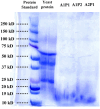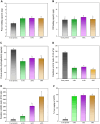Effects of Peptidase Treatment on Properties of Yeast Protein as an Alternative Protein Source
- PMID: 39631785
- PMCID: PMC11729370
- DOI: 10.4014/jmb.2409.09062
Effects of Peptidase Treatment on Properties of Yeast Protein as an Alternative Protein Source
Abstract
Yeast protein, high-quality and high-content microbial protein, can serve as alternative sources of protein. This study examined the structural and functional characteristics of yeast protein through enzymatic treatment using different ratios of alcalase (endo-type) and prozyme 2000P (exo-type) including 2:1 (A2P1), 1:1 (A1P1), and 1:2 (A1P2). After enzymatic hydrolysis, a significant increase in protein solubility from less than 3.1% in untreated proteins to around 16%, particularly at pH 2 or pH 12. Furthermore, a maximum degree of hydrolysis of over 85% was achieved after enzyme treatment. Among them, the highest value of 87.73% was achieved at yeast protein treated by A1P2. Scanning electron microscopy images revealed varied surface morphologies, with exhibiting an increased surface area, particularly after treatment using A2P1. Next, yeast protein treated with A2P1 also demonstrated a superior emulsion stability index (3364.17). However, the antioxidant capacity was higher in proteins treated with A1P2 (78.30%). In addition, the elevated levels of certain amino acids, specifically leucine, lysine, phenylalanine, valine, and arginine, thereby indicating an enhanced amino acid profile was observed. Overall, yeast proteins treated with complex enzymes exhibited improved functionality and potential for diverse food applications.
Keywords: Yeast protein hydrolysates; alternative protein; endotype protease; exotype protease; hydrolysis.
Conflict of interest statement
The authors have no financial conflicts of interest to declare.
Figures






Similar articles
-
Characterization of Yeast Protein Hydrolysate for Potential Application as a Feed Additive.Food Sci Anim Resour. 2024 May;44(3):723-737. doi: 10.5851/kosfa.2024.e33. Epub 2024 May 1. Food Sci Anim Resour. 2024. PMID: 38765283 Free PMC article.
-
Influence of the Degree of Hydrolysis on Functional Properties and Antioxidant Activity of Enzymatic Soybean Protein Hydrolysates.Molecules. 2022 Sep 19;27(18):6110. doi: 10.3390/molecules27186110. Molecules. 2022. PMID: 36144842 Free PMC article.
-
Applying native proteases from melon to hydrolyze kilka fish proteins (Clupeonella cultriventris caspia) compared to commercial enzyme Alcalase.Food Chem. 2019 Mar 30;277:314-322. doi: 10.1016/j.foodchem.2018.10.122. Epub 2018 Oct 26. Food Chem. 2019. PMID: 30502151
-
Bio-functional properties of sardine protein hydrolysates obtained by brewer's spent yeast and commercial proteases.J Sci Food Agric. 2017 Dec;97(15):5414-5422. doi: 10.1002/jsfa.8432. Epub 2017 Jun 13. J Sci Food Agric. 2017. PMID: 28508436
-
Spent brewer's yeast as a source of high added value molecules: a systematic review on its characteristics, processing and potential applications.World J Microbiol Biotechnol. 2020 Jun 24;36(7):95. doi: 10.1007/s11274-020-02866-7. World J Microbiol Biotechnol. 2020. PMID: 32583032
References
MeSH terms
Substances
LinkOut - more resources
Full Text Sources

